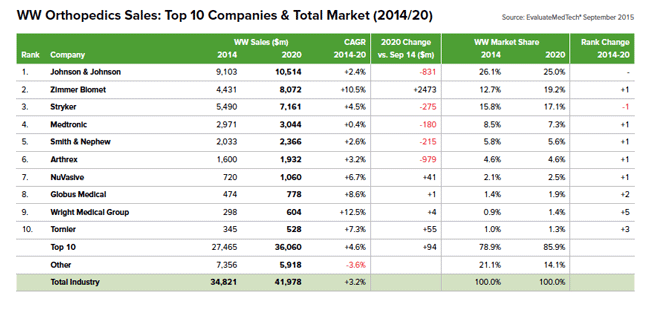 Top Orthopedic Firms and Trends From 2014 to 2020 (QMED byKristopher Sturgis)
Top Orthopedic Firms and Trends From 2014 to 2020 (QMED byKristopher Sturgis)
The orthopedic industry will likely see some significant changes over the next few years. Here are some of the key trends facing the industry, and a brief overview of which companies are leading now, and which are projected to lead in 2020.
With worldwide medtech sales expected to reach $477.5 billion by 2020, the orthopedic device market looks to remain a major player. The industry is slated to rank 3rd in sales behind only cardiology and in vitro diagnostics, according to the analyst firm EvaluateMedTech.
The giants of the industry look to remain largely unchanged as well, as Johnson & Johnson is expected to remain the world’s leading orthopedic company. However, the merger of of Zimmer and Biomet in June of this year could shuffle the landscape by 2020, as the industry continues to adapt to emerging companies and technologies.

From company mergers and new growing markets, to regulatory uncertainty and other industry challenges—we’ve decided to take a look into some of the top orthopedic firms, as well as some of the industry trends as forecasted by EvaluateMedTech.
1. The Significant Challenges Facing The Industry
Orthopedic devices raked in $34.8 billion worldwide in 2014, a mark that earned them 4th in medtech industry sales last year. While the forecast over the next five years predicts that the industry will jump into the top three markets alongside cardiology and in vitro diagnostics , the most recent figures indicate that orthopedics will actually lose about 0.5% of the worldwide market share it currently has by 2020.
With more orthopedic companies relying on third party manufacturers, and regulatory bodies becoming increasingly more risk-averse when it comes to orthopedic implants and devices, agencies like the FDA and the British Standards Institution (BSI) have been coming down hard on firms with poorly managed manufacturing operations. The continued uncertainty surrounding regulation in the sector could become a significant factor in the industry in the coming years.
Between now and 2020, the orthopedic sales market has an expected compound annual growth rate (CAGR) of 3.2%, a figure that has dropped a fair amount from last year’s 4.9%forecast. However, the increased availability of emerging technologies such as robotics, 3D printing, and customizable implants could fuel that growth in the next few years.
2. The Market is Growing Faster in Asia
As we all know, innovation and design are two major driving forces that can create growth and opportunity in medtechmarkets. Recent advancements in nanotechnology, robotics, smart implants, 3D printing, and a myriad of other fields will help the orthopedic device market grow exponentially over the next five years, with the Asia-pacific region becoming a particular hotbed for growth and innovation.
The Asia-pacific region is expected to have the highest annual growth rate (CAGR) in the orthopedic device market than any other geographical region between now and 2020, according to the analyst firm Research and Markets. The region is predicted to see unprecedented growth due to increased healthcare awareness, improved economic growth, and increased government funding. Joint ventures and some significant mergers and acquisitions are expected to play a major role in their market growth over the next few years.
3. Zimmer Biomet Rises Up Through the Ranks
After the merger of Zimmer and Biomet in June of this year, the company (known simply as Zimmer Biomet) is projected to jump seven spots from its 2014 rank in worldwide medtech sales, peaking at 13th in the rankings by 2020.
With an expected growth in orthopedic sales of 10.5% per year (CAGR) between now and 2020, Zimmer Biomet is predicted to have the second largest annual growth rate of any of the top companies in the orthopedic sales industry. The company is expected to bring in worldwide sales of over $8 billion by 2020, nearly double their 2014 output of $4.4 billion.
According to the analyst firm EvaluateMedTech, Zimmer Biomet is projected to leapfrog Stryker in the list of top 10 orthopedic companies, settling in at number two behind only Johnson & Johnson as the world’s leading orthopedic company.
4. Johnson & Johnson Remains the Orthopedic King…For Now
As mentioned in the last section, the general consensus is that Johnson & Johnson will remain the world’s leading orthopedic company, with worldwide orthopedic sales projected to top out at over $10.5 billion by 2020. Johnson & Johnson dominated the market in 2014 when they doubled the worldwide sales figures of every other company on the market except Stryker, whom they still outsold by no slim margin.
However, the emergence of Zimmer Biomet will be one to keep an eye on as industry analysts have predicted that this year’s merger could see the company nearly double their 2014 sales figures, topping out at over $8 billion by 2020. Meanwhile, Johnson & Johnson is also expected to see their market share fall from 26.1% in 2014 to 25% by 2020.
5. Robotics, Custom Implants, and 3D Printing Are Taking Off
Some of the emerging technologies in the orthopedics field could also play a major role in the shaping of the market in the next few years. Robotics and computer navigated surgeries continue to gain momentum as robotic and advanced computer technologies are used in knee and joint replacement surgeries, as well as cartilage repair procedures.
Customized implants are also increasing in the market as the demand for patient-specific implantation rises. Major companies like Stryker, Zimmer Biomet, Medtronic, and many others are now involved in the manufacturing of personalized orthopedic devices and implants.
3D printing also continues to shape the landscape of orthopedic sales, as custom orthopedic instruments continue to be among the most popular applications in the world of 3-D printing. The technology can be used to produce cutting and drilling guides for knee replacements, custom implant devices, and even internal fixation devices such as screws and plates.